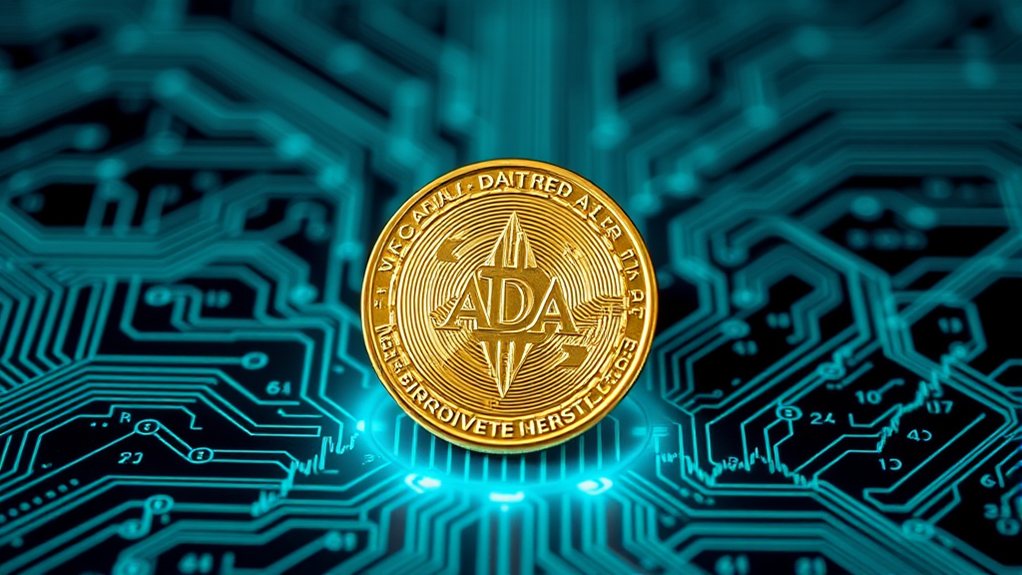Cardano is a blockchain platform founded by Charles Hoskinson in 2015. It runs on a proof-of-stake mechanism called Ouroboros, which uses less energy than Bitcoin. The platform features a native cryptocurrency called ADA and follows a research-driven approach with code written in Haskell. Cardano's development follows five phases: Byron, Shelley, Goguen, Basho, and Voltaire. The platform's layered architecture supports various applications including DeFi and NFTs.

Cardano is a decentralized blockchain platform that's making waves in the cryptocurrency world. Founded in 2015 by Charles Hoskinson, who was also a co-founder of Ethereum, Cardano aims to create a more balanced and sustainable ecosystem for cryptocurrencies and blockchain applications. The platform uses a proof-of-stake consensus mechanism called Ouroboros, which requires much less energy than the proof-of-work systems used by Bitcoin and early versions of Ethereum.
Founded on scientific principles, Cardano revolutionizes blockchain with sustainable technology and visionary leadership.
The native cryptocurrency of Cardano is called ADA, named after Ada Lovelace, a 19th-century mathematician often regarded as the first computer programmer. The ecosystem has a maximum supply cap of 45 billion ADA tokens that will be released over time. ADA consistently ranks among the top cryptocurrencies by market capitalization, with millions of wallets created since its launch. Users can stake their ADA to help secure the network and earn rewards in return.
Cardano's development follows a methodical roadmap divided into five phases: Byron, Shelley, Goguen, Basho, and Voltaire. Each phase introduces new capabilities to the network. The Byron era established the foundation, while Shelley brought decentralization and staking. Goguen added smart contract functionality, allowing developers to build applications on the platform. Basho focuses on scalability improvements, and Voltaire will introduce governance systems.
What makes Cardano stand out is its research-driven approach. The platform's code is written in Haskell, a programming language that allows for formal verification. This means the code can be mathematically proven to work as intended, reducing the risk of bugs and vulnerabilities. For creating smart contracts, developers use Plutus, while Marlowe allows for financial contract development without deep programming knowledge. The platform is built on rigorous academic research that informs every aspect of its development and implementation.
Cardano's layered architecture separates the settlement layer (where transactions occur) from the computation layer (where smart contracts run). This design helps with scalability and allows for updates to one layer without disrupting the other. The platform is also working on solutions like Hydra to process more transactions quickly. This architectural approach includes the specific dual-layer design with the Cardano Settlement Layer for transactions and the Cardano Computational Layer for smart contracts.
The ecosystem supports various applications including decentralized finance (DeFi), non-fungible tokens (NFTs), supply chain tracking, and digital identity verification. Atala PRISM, built on Cardano, offers decentralized identity management solutions.
Despite its strengths, Cardano faces challenges. It's competing with established platforms like Ethereum that have larger developer communities and more applications. Its academic approach, while thorough, sometimes means slower development compared to competitors.
Looking ahead, Cardano aims to achieve full decentralization through its governance model and treasury system. The platform continues to focus on interoperability with other blockchains and sustainability. With hundreds of projects building on its ecosystem and partnerships with governments and enterprises, Cardano is positioning itself as a long-term player in the blockchain space.
Frequently Asked Questions
How Does Cardano Compare to Ethereum?
Cardano and Ethereum are both blockchain platforms with key differences.
Cardano uses a more energy-efficient proof-of-stake system through stake pools, while Ethereum recently switched to proof-of-stake.
Ethereum pioneered smart contracts in 2015, giving it a larger app ecosystem, while Cardano added them in 2021.
Cardano processes transactions faster (250 TPS vs. 15-30 TPS) with lower fees.
Their approaches differ: Cardano is research-driven, while Ethereum develops more rapidly.
Is Cardano a Good Investment?
Cardano's investment potential remains uncertain.
The cryptocurrency offers technical strengths like energy-efficient operations and a capped supply of 45 billion tokens. It's currently among the top 10 cryptocurrencies by market cap and has growing institutional partnerships.
However, it faces challenges including slower development than competitors, limited dApp adoption, and high market volatility.
Like all cryptocurrencies, Cardano carries significant risk alongside its potential rewards.
What Makes Cardano's Consensus Mechanism Unique?
Cardano's consensus mechanism, Ouroboros, stands out as the first provably secure proof-of-stake protocol that's been peer-reviewed by academics.
Unlike other systems, it uses mathematical models to guarantee security while dividing time into epochs and slots for block creation.
It's evolved through multiple versions – from Classic to BFT, Praos, Genesis, and now Hydra – each adding new features while maintaining energy efficiency compared to proof-of-work systems.
Can I Stake ADA and What Rewards Can I Expect?
Cardano users can stake ADA through supported wallets with a minimum of 10 ADA.
There's no lockup period, and staked funds remain accessible. Stakers typically earn 4-6% APY, with rewards distributed every 5 days.
First rewards arrive after 15-20 days. The process doesn't require technical skills and helps secure the network.
Over 3,000 stake pools are available, each with different fees and performance metrics.
What Major Partnerships Has Cardano Established?
Cardano has formed several major partnerships.
In March 2025, they announced a strategic alliance with SERPRO, Brazil's government IT service. They've also partnered with Petrobras, Brazil's state-owned oil company, to offer blockchain education to 40,000 employees.
Academic collaborations include the University of Zurich and Argentina's UTN.
Industry partnerships feature veritree, Rival, UBX, and AID:tech, expanding Cardano's real-world applications across different sectors.










